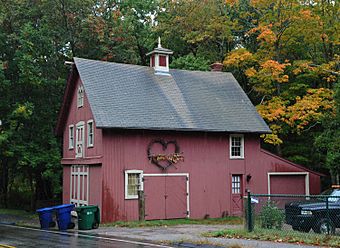Graniteville Historic District (Waterford, Connecticut) facts for kids
Quick facts for kids |
|
|
Graniteville Historic District
|
|

Barn on Rope Ferry Road
|
|
| Location | Rope Ferry Rd., Waterford, Connecticut |
|---|---|
| Area | 25 acres (10 ha) |
| NRHP reference No. | 03000812 |
| Added to NRHP | August 28, 2003 |
The Graniteville Historic District is a special neighborhood in Waterford, Connecticut. It's a place where many old homes and buildings are protected because they show us what life was like long ago. This district is mostly made up of houses where people who worked in granite quarries used to live.
The area is located along Rope Ferry Road. This road was once very important for the granite industry in Waterford. Many of the 31 historic buildings here are simple homes for quarry workers. But there are also a few unique buildings. These include the old Graniteville School, built around 1878, and the house of John Palmer. He was one of the owners of the quarries. His house, updated around 1860, is the fanciest one in the district. The Graniteville Historic District was added to the National Register of Historic Places in 2003. This means it's recognized as an important historical site.
Contents
Discovering Graniteville's Past
Waterford was first settled a very long time ago, in the 1600s. For a while, it was part of New London. But in 1801, it became its own town.
The Story of Granite Quarrying
The history of digging for granite in Waterford began early. As far back as 1737, a person named Edward Buor started quarrying stones. He used these stones to build grist mills, which ground grain into flour. The place where his quarry was located became known as Millstone Point. Today, the Millstone Nuclear Power Plant is there.
Granite quarrying became a much bigger business in the 1800s. It was the largest industry in Waterford that wasn't farming. People needed granite for buildings, bridges, and other construction projects.
How Graniteville Grew
The Graniteville community started to form in the 1840s and 1850s. It was a group of houses built for the many people who worked in the granite quarries. These homes were all along Rope Ferry Road. Back then, this road was the main way to travel between New London and Lyme.
Exploring the Historic District
The Graniteville Historic District is actually made up of three separate parts. Two of these parts are old, abandoned quarries. They are located to the west and northwest of the main village area.
The main village part stretches along Rope Ferry Road. It goes from Spithead Road all the way to Gardiners Wood Road.
Homes and Buildings You'll See
Most of the houses in Graniteville were built in a style called Greek Revival. This style was popular in the 1800s and often featured simple, strong shapes. John Palmer's house is a great example of the Italianate style. This style often has decorative brackets under the roof and tall, narrow windows.
The old Graniteville School also shows the Italianate style. You can also find some examples of Carpenter Gothic architecture. This style uses wood to create decorative patterns, often seen on porches or rooflines. A barn at 227 Rope Ferry Road is a good example of this unique style.



